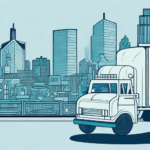Understanding Last Mile Hubs
Last mile hubs are pivotal in the logistics industry, serving as the final transfer points where goods are consolidated before being delivered to customers. These hubs are strategically located to optimize delivery routes, reduce transportation costs, and enhance customer satisfaction. By positioning last mile hubs closer to delivery destinations, businesses can ensure timely and efficient deliveries, meeting the growing consumer demand for rapid service.
Importance in Logistics
Last mile hubs play a crucial role in bridging the gap between central distribution centers and end consumers. They enable faster deliveries, reduce the distance delivery vehicles need to travel, and minimize the environmental impact by optimizing routes. According to a McKinsey report, efficient last mile delivery can significantly enhance customer satisfaction and loyalty.
Types of Last Mile Hubs
- Micro Hubs: Small, localized hubs that facilitate deliveries by foot or bicycle, ideal for urban areas.
- City Centers: Centralized distribution points with larger capacities, supporting high-volume deliveries.
- Transfer Hubs: Intermediate points that connect warehouses with delivery vehicles, streamlining the distribution process.
- Cross-Dock Hubs: Facilities where shipments from multiple suppliers are consolidated and redistributed, commonly used in retail.
- Mobile Hubs: Adaptable delivery trucks serving as mobile warehouses, particularly useful in rural or hard-to-reach areas.
Challenges in Last Mile Delivery
Despite their benefits, last mile delivery faces several challenges that can hinder efficiency and customer satisfaction.
Traffic Congestion and Weather Conditions
Urban areas often experience heavy traffic congestion, leading to delays and increased fuel consumption. Additionally, adverse weather conditions can disrupt delivery schedules and impact the reliability of services.
Security Concerns
With the rise of package theft and porch piracy, ensuring the security of deliveries is paramount. Implementing measures such as secure delivery locations, signature confirmations, and real-time tracking can help mitigate these risks.
Failed Deliveries
Failed deliveries occur when recipients are unavailable or when there are issues with the delivery address. This not only incurs additional costs but also affects customer satisfaction. Solutions like real-time communication and flexible delivery options can help reduce the rate of failed deliveries.
Technology and Innovations
Advancements in technology are transforming last mile delivery, making it more efficient and reliable.
Tracking Solutions
GPS and real-time tracking systems enable businesses to monitor the location of delivery vehicles, optimize routes, and provide customers with accurate delivery estimates. According to a Statista report, real-time tracking has become a standard expectation among consumers.
Machine Learning and Data Analytics
Machine learning algorithms analyze data on traffic patterns, delivery routes, and customer behavior to optimize delivery operations. This leads to improved efficiency, reduced costs, and enhanced customer experiences.
Autonomous Vehicles and Drones
Emerging technologies like autonomous delivery vehicles and drones offer innovative solutions for last mile delivery, enabling faster and more cost-effective service. Companies such as Walmart and Amazon are actively exploring these technologies to enhance their delivery capabilities.
Crowdsourcing
Crowdsourcing utilizes a network of independent contractors or individuals to deliver packages, providing flexible and scalable delivery options. This approach can reduce delivery times and operational costs while increasing delivery capacity.
Best Practices for Managing Last Mile Hubs
Effective management of last mile hubs is essential for ensuring smooth operations and high customer satisfaction.
Effective Communication and Training
Ensuring clear communication and providing comprehensive training to delivery personnel are fundamental for efficient operations. Well-trained staff can handle deliveries more effectively and adapt to unexpected challenges.
Route Optimization
Utilizing route planning software that considers traffic, delivery windows, and vehicle capacity can significantly enhance delivery efficiency. Optimized routes reduce delivery times and fuel consumption, contributing to cost savings.
Inventory Management
Implementing robust inventory management systems helps monitor stock levels, track incoming and outgoing shipments, and ensure that products are stored correctly. This prevents stockouts, minimizes waste, and ensures timely deliveries.
Automation of Routine Tasks
Automating repetitive tasks such as sorting, labeling, and tracking can improve operational efficiency and reduce the likelihood of human error. Automation also allows staff to focus on more critical aspects of the delivery process.
Implementing Last Mile Hubs
Successful implementation of last mile hubs requires careful planning and consideration of various factors.
Evaluating Business Needs
Businesses must assess their delivery volumes, geographical reach, and customer expectations to determine the necessity and scale of last mile hubs. Understanding the specific requirements of different product types, such as perishable or high-value items, is also crucial.
Choosing the Right Location
Selecting an optimal location for last mile hubs involves evaluating proximity to delivery areas, accessibility, availability of parking space, and security measures. A well-located hub minimizes delivery distances and enhances operational efficiency.
Selecting a Third-Party Logistics Provider
Outsourcing last mile delivery to third-party logistics providers can offer expertise and scalability. When choosing a provider, businesses should consider factors such as the provider’s experience, reputation, technological capabilities, and cost-effectiveness.
Measuring and Optimizing Performance
Monitoring the performance of last mile hubs is essential for continuous improvement and achieving business objectives.
Key Performance Metrics
- Delivery Times: Average time taken to deliver packages.
- Customer Satisfaction: Feedback and ratings from customers.
- Cost Per Delivery: Total delivery costs divided by the number of deliveries.
- Delivery Success Rate: Percentage of successful deliveries on the first attempt.
Data Analytics
Leveraging data analytics helps identify bottlenecks and inefficiencies in the delivery process. Analyzing trends and patterns enables businesses to make informed decisions and implement effective strategies for optimization.
Continuous Improvement
Adopting a culture of continuous improvement ensures that last mile delivery operations remain efficient and adaptable to changing market conditions. Regularly reviewing performance metrics and seeking feedback from customers and employees can drive ongoing enhancements.
Future Trends and Opportunities
The last mile delivery landscape is evolving with emerging trends and innovations that offer new opportunities for businesses.
Sustainability Initiatives
Increasing awareness of environmental impact is driving the adoption of sustainable delivery practices. Utilizing electric vehicles, bicycles, and other eco-friendly transportation methods reduces carbon emissions and promotes sustainability.
Predictions for the Future
The future of last mile hubs is expected to be shaped by advancements in technology and changing consumer behaviors. Predictions include the widespread use of autonomous delivery vehicles, integration of artificial intelligence for smarter logistics, and the expansion of urban micro hubs to meet the demands of growing city populations.
Opportunities for Innovation
Businesses have the opportunity to innovate by exploring new delivery models, such as subscription-based services, locker-based deliveries, and personalized delivery options. Embracing these innovations can provide a competitive edge and enhance the overall delivery experience for customers.
Case Studies: Successful Implementations
Several companies have successfully implemented last mile hubs, demonstrating the benefits of this approach.
Amazon Prime Now
Amazon's Prime Now service leverages last mile hubs to offer ultra-fast delivery options, often within two hours. This service has significantly boosted customer satisfaction and loyalty, setting a high standard in the e-commerce industry.
UPS Access Point Network
UPS's Access Point network utilizes a wide range of local businesses as delivery hubs, providing customers with convenient pickup and drop-off locations. This model has enhanced delivery flexibility and reduced the cost of failed deliveries.
FedEx SameDay City
FedEx's SameDay City service uses strategically placed hubs to provide same-day delivery in urban areas. This initiative has improved delivery speed and reliability, catering to the needs of time-sensitive shipments.
Conclusion
Last mile hubs are essential for modern logistics, offering numerous benefits such as improved delivery efficiency, reduced costs, and enhanced customer satisfaction. By addressing the challenges and leveraging the latest technologies, businesses can optimize their last mile delivery operations and stay competitive in a rapidly evolving market. As the industry continues to innovate, the role of last mile hubs will become increasingly critical in shaping the future of logistics.






















